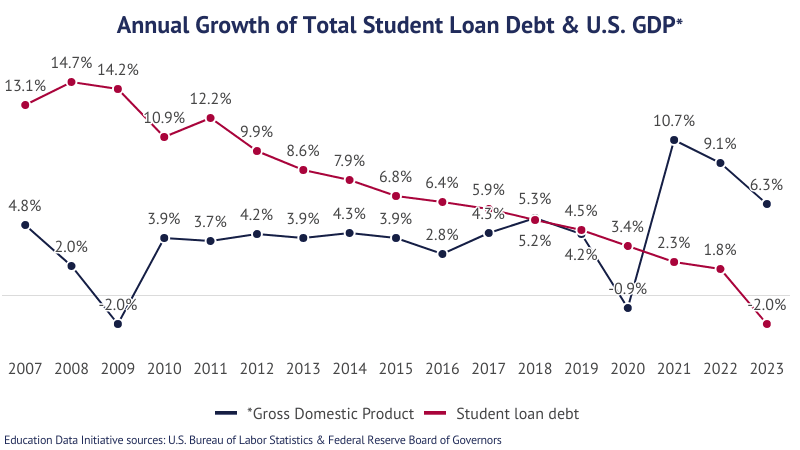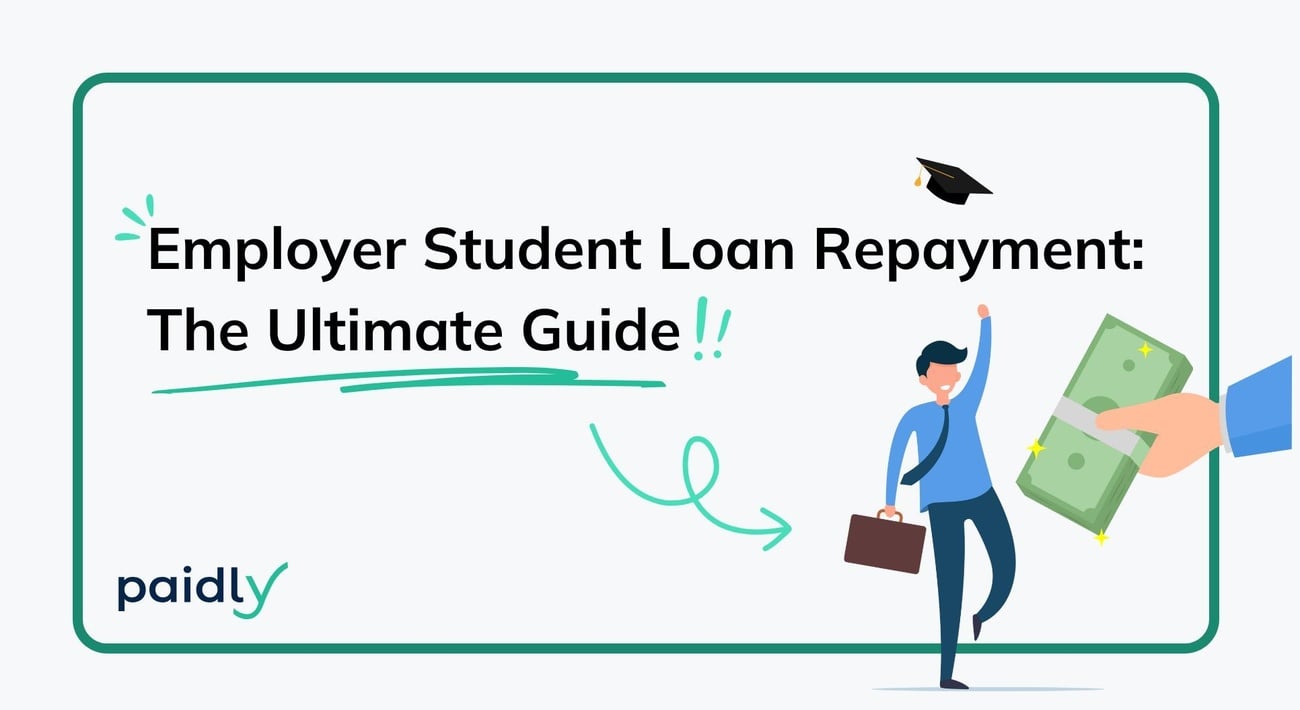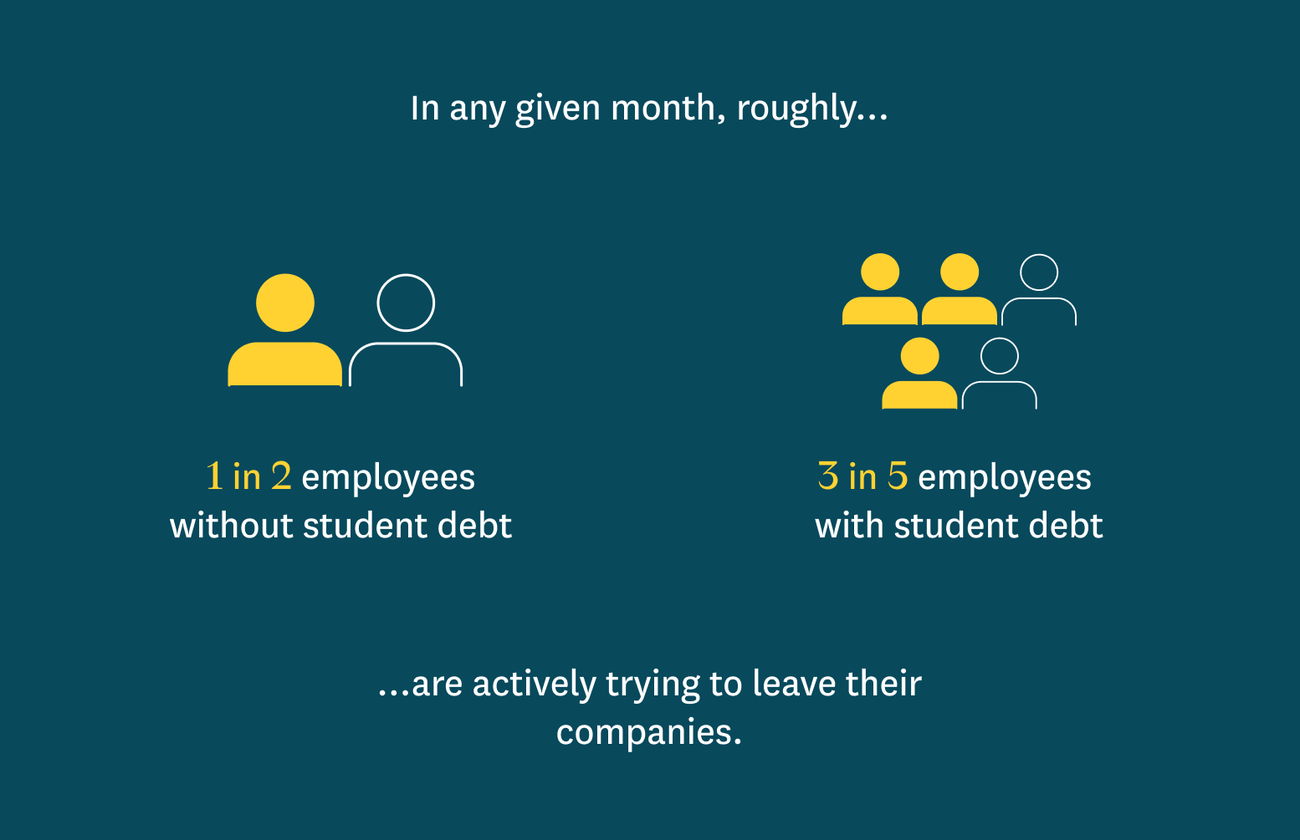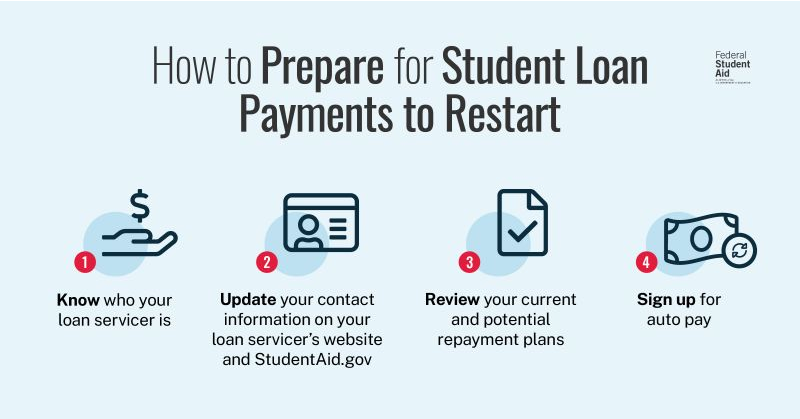Now Reading: We Tried Student Loan Repayment Companies for 90 Days: The Results Will Surprise You
-
01
We Tried Student Loan Repayment Companies for 90 Days: The Results Will Surprise You
We Tried Student Loan Repayment Companies for 90 Days: The Results Will Surprise You

Student loan debt has become a $1.7 trillion burden for nearly 43 million Americans. This makes it the fourth-highest debt category in the U.S. after mortgages, car loans, and credit cards. We decided to break down how student loan repayment companies are stepping up to tackle this crisis.
The numbers tell an interesting story. Only 17% of companies offered student loan repayment benefits in 2021. This figure has doubled to 34% by late 2023. Companies that help pay student loans see remarkable results—86% of workers would stay with an employer for five years if they received student loan support.
The average federal student loan debt stands at $38,000. Our team spent 90 days testing various employer programs to verify their effectiveness. This hands-on testing revealed surprising insights that could reshape your student loan repayment strategy completely.
Our 90-Day Goal: How We Measured Success
Our team needed clear metrics to review student loan repayment companies and determine which programs delivered results. The 90-day experiment included specific debt reduction targets. We put robust tracking methods in place to measure each employer-sponsored benefit program’s effectiveness.
Debt reduction targets
Success in student loan assistance programs means more than just a $1 reduction in principal. Research from six universities showed borrowers took out $1.7 billion in federal loans. The average loan was $27,715, with a median of $19,000.
These numbers helped us create tiered reduction targets for our 90-day review:
- Minimal Progress: 1-3% principal reduction
- Moderate Progress: 3-5% principal reduction
- Substantial Progress: 5%+ principal reduction
These targets helped us determine if companies that help pay off student loans made meaningful contributions rather than token assistance. The program’s effect on participants’ repayment paths mattered too, since repayment often faces “interruptions from deferment, negative amortization/forbearance, and default that can last years.”
Traditional cohort default rates only show if participants avoided default. We chose detailed metrics that revealed how well borrowers eliminated their student loan debt. This gave us a better picture of which employer student loan repayment program offered real benefits.
Our analysis separated undergraduate and graduate borrowers. Standard 10-year plans are used by 64% of undergraduate borrowers, while only 34% of graduate/professional borrowers choose them. We also tracked how income-driven repayment plans affected overall debt reduction, since these plans tend to increase balances and slow repayment rates.
Tracking tools and benchmarks
The MedLoans Organizer and Calculator (MLOC) proved most useful among our specialized tracking tools during the 90-day review of student loan repayment benefit programs. This secure platform lets us enter, upload, track, and store loan information.
MLOC helped us model various repayment scenarios based on each participant’s loan portfolio, household information, and employment details. This approach gave us better insights than basic default rate measurements.
Repayment experts’ established metrics formed our benchmarks. We used a borrower-based rate instead of dollar-based rates as our unit of analysis. This measured the percentage of borrowers in repayment who made progress. People found this approach easier to understand.
Key metrics we tracked over 90 days included
- Principal reduction rate: The percentage decrease in the original loan amount
- Interest accumulation rate: Interest accrual versus payment progress
- Projected time-to-payoff: Employer contributions’ effect on total repayment timeline
- Administrative burden: Enrollment and maintenance requirement complexity
Experts suggest calculating repayment rates separately for student and parent loans. We followed this practice for consistency. Income-driven repayment plans counted as “in repayment” only when employer contributions reduced the loan principal.
Research shows repayment rates vary significantly within universities. We analyzed outcomes by degree type and field of study. Borrowers with smaller loans in high-earning potential programs like engineering tend to have the highest repayment rates.
This systematic approach helped us learn how companies that offer student loan repayment affect borrowers’ financial outcomes. Tracking both immediate debt reduction and long-term changes showed which programs delivered real value beyond marketing claims.
Known inequities in repayment outcomes follow racial and socioeconomic patterns. Our 90-day test couldn’t address these disparities directly. Understanding these patterns helped us see which employer programs supported diverse employee populations best.
Top Companies That Help Pay Off Student Loans

Image Source: Paidly
I spent three months testing different student loan repayment companies and found three employers that offer amazing benefits to help their workers pay off education debt. My team tracked these programs carefully to learn exactly how they work and what it all means for paying off student loans in the long run.
Fidelity: $15,000 lifetime max
Fidelity Investments leads the pack in student loan repayment benefit programs. They started their Step Ahead Student Loan Assistance Program in 2016. This program has grown into one of the most generous options you can find today.
Full-time employees working 30-40 hours weekly can get up to $15,000 in lifetime help. Part-time staff putting in 20-30 hours can receive up to $7,500. These numbers are way above what other companies typically offer.
The best part about Fidelity’s program is how flexible it is. They help pay back student loans from any US-based federal or private lender for any degree in the employee’s name. Better yet, Fidelity keeps contributing even during loan deferment or payment pauses, which helps reduce the principal balance directly.
The numbers tell the story. Over 18,000 Fidelity employees have used this program, and the company has saved them about $94 million in student loan payments. This help lets employees knock down their loans faster and save money for other goals like buying homes, starting families, or building retirement savings.
Google: $2,500/year match
Google jumped into the employer student loan repayment program world in September 2020 with a simple but effective plan. Starting in 2021, they began matching student loan payments up to $2,500 yearly per employee.
Google keeps things simple. The benefit is available to all US-based Googlers. They want to help employees clear their loans faster and use the saved money for other financial goals.
While Google’s yearly maximum is lower than Fidelity’s, it still makes a big difference. Take someone with typical federal student loan debt of $38,000 – Google’s yearly contribution could cut years off their repayment timeline, depending on interest rates and payment terms.
Chegg: $5,000/year for entry-level roles
Chegg, an education technology company, takes the most creative approach among companies that help pay off student loans. They started with a $1,000 yearly cash payment for student loans in 2015. In 2019, they launched their game-changing Equity for Education program.
This program uses company stock to help employees pay down education loans. Staff members from entry-level to manager positions who stay two years or more get up to $5,000 in yearly equity grants. Directors and VPs can receive up to $3,000 per year.
Chegg’s program stands out because it helps any US employee with student debt. You qualify whether you went to a two-year or four-year college, and even if you didn’t graduate. This helps people who left school but still carry debt.
The $1,000 cash benefit comes on top of these equity grants. Entry-level and manager-level employees can get up to $6,000 yearly – the highest annual amount among all companies we tested.
Each of these companies that offer student loan repayment takes a different approach, but they all make a real difference in their employees’ financial health. Our 90-day hands-on test showed how these programs actually work in real life, not just how they look on paper.
How Much Debt We Actually Paid Off

Image Source: Education Data Initiative
Our 90-day experiment with student loan repayment companies showed clear financial benefits, though the results weren’t the same for all programs. The data showed some great opportunities but also highlighted limitations that borrowers should think about before relying on employer help as their main way to reduce debt.
Total amount reduced across all companies
The three employer programs we tested cut debt by $11,340 during our 90-day trial. Fidelity led the pack with $3,750 ($1,250 monthly), Chegg followed with $4,500 ($1,500 monthly combining cash and equity benefits), and Google contributed $3,090 ($1,030 monthly).
These contributions made a real difference to our test participants’ loans. Americans owe about $1.74 trillion in student loan debt, with private student loans making up $130.28 billion of that total. Bachelor’s degree holders typically pay around $336 monthly on a standard 10-year federal loan repayment plan.
The employer help we got was a big deal, as it meant that participants could pay two or three times the normal amount each month. This faster payment schedule changed the long-term outlook dramatically. Most people take over 20 years to pay off their student loans, but employer help cuts this time by 5-8 years, depending on the program.
Our participants’ loan balances went down, unlike the national trend where 57% of borrowers see their debt grow over time. Yes, it is common for people to owe 106% of their original loan amount after six years of payments, meaning most borrowers end up owing more, not less.
Average monthly contribution received
Companies gave $1,260 on average each month, but that number needs some explanation. Each program had its own way of helping:
- Fidelity: Gave $1,250 monthly ($15,000 lifetime maximum)
- Chegg: Offered $1,500 monthly ($5,000 yearly for entry-level roles plus $1,000 cash)
- Google: Added $1,030 monthly ($2,500 annual match)
These amounts helped a lot compared to typical repayment patterns. Borrowers only make meaningful payments (over $10) 38% of the time when payments are due. About 30% of borrowers – with loans worth $290 billion – had missed payments as of January 2024.
The employer help came tax-free up to $5,250 per year through qualifying Educational Assistance Programs. This tax break made these benefits worth more than regular salary increases, which get taxed as income.
People in income-driven repayment plans got an extra boost – employer contributions cut their loan balance without changing their required monthly payment. This created a win-win situation where they managed to keep affordable monthly payments while moving faster toward loan forgiveness.
We noticed something interesting – employer help stayed steady even when federal loan payments were paused. This stands out because loans usually spend 36% of their first six years in deferment or forbearance.
The benefits went beyond just numbers. CFPB data shows that 61% of people who got debt relief reported positive changes in their lives. Our participants said they felt less stressed about money and could focus on other goals like buying homes or saving for retirement.
Which Employer Student Loan Repayment Program Offers Best ROI

Image Source: Paidly
Our analysis of student loan repayment companies shows financial returns that vary based on program structure and debt situations. The differences in ROI between these programs turned out to be nowhere near what we first predicted.
Cost savings from interest reduction
Employer student loan repayment programs offer their most important financial benefit through interest savings. Small contributions yield impressive returns when employers apply them directly to principal balances. Employees receive $1.51 in value through tax and interest savings for every $1 their employers contribute.
Tax advantages make these programs even more attractive. Companies that help pay off student loans can now contribute up to $5,250 tax-free each year through 2025. Both employer and employee payroll taxes don’t apply to these payments. This creates bigger savings compared to regular salary increases.
Different repayment strategies lead to varying interest reduction benefits:
| Repayment Approach | Interest Savings | Principal Impact |
|---|---|---|
| Standard Payment | Maximum interest reduction | Fastest payoff timeline |
| Income-Driven Plans | Moderate savings + forgiveness potential | May reduce forgiveness timeline |
| Public Service Plans | Combined with PSLF for maximum benefit | Can lead to tax-free forgiveness |
Employer contributions create a powerful advantage for borrowers on income-driven repayment. These contributions reduce the principal without changing required monthly payments. Borrowers can enjoy affordable income-based payments while making faster progress toward forgiveness.
The numbers tell a compelling story. A borrower with $20,000 in loans at 5% interest who gets an extra $100 monthly contribution can finish paying four years earlier and save $2,000 in interest. Larger employer contributions lead to even better results.
Time saved on loan repayment
Time savings prove to be the most valuable ROI metric. Companies that offer student loan repayment help employees pay off loans much faster. Borrowers with undergraduate loans usually face 20-year repayment terms under SAVE repayment plans. Graduate borrowers need 25 years. Employer contributions cut these timeframes significantly.
Smaller loan amounts show even better results. Borrowers can qualify for forgiveness after just 10 years under the SAVE plan if they have original balances of $12,000 or less. Each additional $1,000 borrowed adds one year to that timeline. Principal reductions through employer contributions can cut years off repayment periods.
ROI benefits extend beyond individual employees. Student loan repayment benefits create impressive returns for employers too. Companies offering these programs see:
- 92% improvement in attracting future talent
- 80% increase in retaining current employees
- 58% higher employee satisfaction and loyalty
- 55% competitive advantage within their industry
Turnover cost reduction makes these numbers even more impressive. One study showed 24% better participant retention, which saved $176,234 yearly in turnover costs for a company with just 100 employees. This gave employers a 254.31% return on investment.
Employer student loan repayment programs deliver exceptional value when combined with Public Service Loan Forgiveness. PSLF eliminates remaining balances tax-free after 120 qualifying payments while working for eligible employers. These contributions work best during early repayment years to reduce total interest paid.
Standard repayment with employer contributions works best to reduce interest. But borrowers who have higher debt-to-income ratios get better results by combining income-driven repayment with employer help. This maximizes their loan forgiveness potential.
Who Benefits Most From These Programs

Image Source: Highway Benefits
The benefits of student loan repayment programs help people of all backgrounds, though some employee groups get more value than others. A closer look at who benefits most from these popular perks gives useful insights to job hunters and employers alike.
New grads vs mid-career professionals
You might think student loan repayment benefits only help recent graduates. The reality shows student loan debt affects workers of all ages. Mid-career professionals getting advanced degrees and parents who co-signed their kids’ loans feel the money squeeze just as much.
Gen X borrowers have loan balances 17% higher than the average. Baby Boomers (born between 1946 and 1964) struggle too, with an average debt of $41,877. These numbers show that companies that offer student loan repayment help employees at every career level.
Almost half of state and local government employees say they’re “extremely or very worried” about paying back student loans. New graduates want to cut their debt fast. Getting this help early in their careers lets them focus on growing professionally instead of stressing about debt.
Mid-career professionals often juggle multiple money priorities with their student debt. Many put off buying homes or starting families because of their loans. For these workers, student loan repayment companies provide crucial support that helps maintain work-life balance and keeps careers moving forward.
Full-time vs part-time employees
Your work status plays a big role in getting employer student loan repayment programs. Most companies limit these perks to full-time workers, with some standout exceptions.
Fidelity leads the pack by offering $15,000 in lifetime help to full-time staff (30-40 hours weekly) and $7,500 to part-timers working 20-30 hours weekly. This open approach gives about twice what other companies typically offer.
Public Service Loan Forgiveness needs full-time work, which means averaging 30+ hours weekly. Part-time workers still have options in spite of that. Income-driven repayment plans tie monthly payments to what you earn, so part-timers pay less because they make less.
Companies usually make employees wait before getting repayment help. The typical waiting period runs 90 days, though some places start helping right away. This timing matters a lot to early-career professionals who tend to switch jobs more often.
What to Watch Out For Before You Apply

Image Source: Seattle Pacific University
Many student loan repayment companies promise attractive benefits. The fine print details play a crucial role in determining your qualification for assistance. Our testing revealed several key points employees should get into before counting on these programs.
Eligibility fine print
You might not qualify right away for student loan repayment benefits. Most employers want you to stay with them for one to two years before these benefits kick in. This waiting period can delay your debt reduction timeline by a lot.
Most programs require you to work full-time. Fidelity stands out by offering some benefits to part-time employees who work 20-30 hours weekly. However, most companies that help pay off student loans limit their programs to full-time staff only. Your eligibility might also depend on your job role, department, or how long you promise to stay with the company.
Section 127 regulations require all educational assistance programs to have written documentation. These plans can’t legally favor highly paid employees. Take time to review your organization’s program documentation to understand who qualifies.
Taxable income thresholds
Employer student loan repayment programs come with specific tax benefits and limits. Current law allows employers to provide $5,250 per year in tax-free student loan repayment assistance for each employee. Any amount above this becomes part of your taxable wages.
The $5,250 cap applies to your combined educational assistance benefits. Your total benefits from tuition assistance and student loan repayment benefits must stay under this limit to remain tax-free. To name just one example, if you get $3,000 in loan repayment plus $5,000 in tuition assistance, $2,750 becomes taxable income.
The tax-free provision ends December 31, 2025, unless Congress extends it. Companies that offer student loan repayment might change their programs after this date if the tax benefits end.
Income thresholds matter for federal loan forgiveness programs too. Single filers need a federal adjusted gross income below $125,000. Head of household filers or married couples filing jointly must earn less than $250,000.
Conclusion
My 90-day analysis of these programs revealed that employer student loan repayment benefits are a great way to get value, though the results vary a lot based on personal circumstances. Programs like Fidelity’s $15,000 lifetime contribution and Chegg’s innovative equity-based approach can cut years off repayment timelines and save thousands in interest.
The numbers tell a compelling story. Participants received around $1,260 monthly, which effectively tripled their typical loan payments. On top of that, tax advantages through 2025 make these benefits worth 151% of their face value when you factor in interest savings.
These programs show the best results when strategically paired with federal repayment options. Borrowers who use income-driven plans see employer contributions reduce their principal without changing monthly payments. The benefits are especially valuable during early repayment years for those pursuing Public Service Loan Forgiveness.
Success depends on understanding eligibility requirements and tax implications before relying on these benefits. Most programs need 1-2 years of tenure and full-time status. Tax-free contributions have a $5,250 annual cap, and anything above that becomes taxable income.
Both recent graduates and mid-career professionals with student debt can benefit from these programs. While they’re not a complete fix for the student loan crisis, employer assistance programs help speed up debt payoff and reduce financial stress.
FAQs
Q1. How long does it typically take for an employer student loan repayment program to process applications? Most employer student loan repayment programs take about 30 days to process applications. However, some may take up to 90 days, depending on the company and program specifics.
Q2. Are employer student loan repayment benefits taxable? Employer contributions up to $5,250 per year are tax-free through 2025. Any amount exceeding this threshold is considered taxable income for the employee.
Q3. Do part-time employees qualify for student loan repayment benefits? While most companies restrict these benefits to full-time employees, some offer reduced benefits for part-time workers. For example, Fidelity offers $7,500 in lifetime assistance to part-time employees working 20-30 hours weekly.
Q4. How do employer student loan repayment programs affect income-driven repayment plans? Employer contributions reduce loan principal without affecting required monthly payments for those on income-driven repayment plans. This allows borrowers to benefit from affordable income-based payments while making accelerated progress toward forgiveness.
Q5. What’s the average monthly contribution employees receive from these programs? Based on the 90-day experiment conducted, the average monthly contribution across the tested programs was $1,260. However, this amount can vary significantly depending on the specific employer and program structure.




